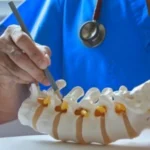Introduction
For athletes, spinal injuries can be career-threatening setbacks. The traditional approach to spine surgery often means lengthy recovery periods, significant muscle damage, and uncertain returns to peak performance. However, modern medical advancements have revolutionized treatment options. Endoscopic spine surgery has emerged as a game-changing procedure for athletes dealing with spinal issues, offering faster recovery and better outcomes. Athletes seeking specialized care should consult with an endoscopic spine surgeon in Rohini Delhi for optimal results.

This minimally invasive approach uses specialized instruments and tiny incisions to address spinal problems while preserving surrounding tissues. For professional athletes, where time away from training and competition directly impacts careers, the accelerated recovery timeline makes endoscopic procedures particularly valuable. Modern techniques like endoscopic back surgery in Delhi offer significant advantages for athletes with spine issues.
At Sant Parmanand Hospital in Delhi, athletes have access to cutting-edge endoscopic spine surgery techniques that minimize recovery time while maximizing outcomes. This comprehensive guide explores how endoscopic spine surgery is transforming recovery for athletes and why it has become the preferred option for sports professionals dealing with spinal conditions.
Understanding Endoscopic Spine Surgery and Its Benefits for Athletes
What Makes Endoscopic Spine Surgery Different
Endoscopic spine surgery represents a significant advancement over traditional open surgery methods. Unlike conventional approaches that require large incisions and muscle retraction, endoscopic techniques utilize specialized tools inserted through incisions often smaller than a centimeter. A high-definition camera provides surgeons with magnified views of the surgical area, allowing for precise intervention with minimal collateral damage.
The endoscopic spine surgery recovery process is significantly faster compared to traditional open surgery methods. This technique offers several distinct advantages:
- Smaller incisions (typically 7-8mm compared to several inches)
- Minimal blood loss during the procedure
- Significantly reduced muscle damage
- Lower infection rates
- Decreased postoperative pain
- Shorter hospital stays (often outpatient or 1-day stays)
- Enhanced visualization during surgery
For professional athletes, consulting with the best endoscopic spine surgeon in Parmanand Hospital Delhi can make a crucial difference in recovery outcomes. The hospital’s advanced facilities support these minimally invasive procedures with state-of-the-art equipment and specialized care teams.
Why Athletes Prefer Advanced Back Surgery Options in Delhi
Athletes face unique challenges when undergoing spine surgery. Their livelihoods depend on physical performance, making any compromise in function potentially career-ending. Additionally, the time away from training and competition can have significant professional and financial implications.
Endoscopic techniques address these concerns directly. Studies comparing traditional and endoscopic approaches show remarkable differences in recovery timelines. While conventional spine surgery typically requires 5.2 to 8.7 months before return to play, endoscopic procedures can reduce this to approximately 3 months—a critical difference for athletes with time-sensitive competitive schedules.
The preservation of muscle tissue is another significant advantage. Traditional approaches often involve cutting through and retracting muscles, leading to weakness and atrophy during recovery. Endoscopic techniques minimize this damage, allowing athletes to maintain more muscle mass and strength throughout the recovery process.
Modern techniques like endoscopic back surgery in Delhi offer significant advantages for athletes with spine issues. The procedure’s precision allows surgeons to address the specific problem without disturbing surrounding structures, preserving the biomechanical stability so crucial for athletic performance.
Understanding Endoscopic Spine Surgery Recovery for Athletes
The Recovery Timeline
One key advantage of undergoing endoscopic spine surgery for athletes is the accelerated recovery timeline. The average endoscopic spine surgery recovery time for athletes is approximately three months compared to 5-9 months for traditional surgery. The process unfolds across several distinct phases:
Immediate Post-Operative Phase (1-2 weeks)
- Initial rest and wound healing
- Pain management and basic mobility
- Limited physical activity
Early Recovery Phase (2-6 weeks)
- Progressive increase in activity levels
- Beginning of targeted rehabilitation exercises
- Core strengthening and stability work
Advanced Recovery Phase (6-12 weeks)
- Sport-specific training introduction
- Gradual return to higher-intensity activities
- Functional movement pattern restoration
Return to Sport Phase (12+ weeks)
- Sport-specific drills at full intensity
- Competitive simulation training
- Monitored return to competition
Many patients ask how long it takes to recover from endoscopic spine surgery, and for athletes, the timeline is typically shortened due to their physical conditioning. However, individual recovery varies based on the specific procedure, the athlete’s condition, and their adherence to rehabilitation protocols.
Optimizing Spine Surgery Recovery for Athletes: Timeline and Expectations
Specialized spine surgery recovery for athletes includes customized rehabilitation protocols to ensure safe return to sports. This recovery process is carefully structured to balance the need for healing with the athlete’s desire to return to training and competition.
Key factors that influence recovery include:
- The specific procedure performed – Some endoscopic interventions, such as discectomies, typically have faster recovery times than more complex procedures.
- The athlete’s pre-surgery condition – Athletes in better physical condition generally recover more quickly.
- Adherence to rehabilitation protocols – Following prescribed exercises and activity restrictions significantly impacts recovery speed.
- Sport-specific demands – Recovery timelines may vary based on the physical demands of the athlete’s particular sport.
Understanding what to expect during recovery from endoscopic spine surgery helps athletes mentally prepare for the rehabilitation process. Having achievable expectations plays a key role in supporting emotional health during recovery, as unrealistic timelines can lead to frustration and potentially harmful attempts to accelerate the process.
Impressive Endoscopic Spine Surgery Success Rate for Athletic Patients
Return to Play Statistics
The data on endoscopic spine surgery outcomes for athletes is particularly encouraging. Studies show that the endoscopic spine surgery success rate exceeds 88% for athletic patients returning to their sport. This compares favorably to the approximately 81% success rate for traditional open procedures.
More specifically, research indicates:
- 95% of athletes return to original performance levels within 9.2 weeks
- 100% return to pre-injury activity levels reported in some studies within 2-3 months
- For lumbar surgeries: 75-100% return to play rate
- For cervical surgeries: 83.3-100% return to play rate
These statistics highlight why endoscopic approaches have become increasingly preferred for athletes with spine conditions. The combination of faster recovery and high success rates makes these procedures particularly valuable for those whose careers depend on physical performance.
Factors Affecting Endoscopic Spine Surgery Recovery Time
Several factors can influence how quickly an athlete recovers from endoscopic spine surgery:
Surgical Factors:
- Exact location and type of spinal issue addressed
- Complexity of the procedure
- Surgeon’s experience with endoscopic techniques
Patient Factors:
- Age and overall health
- Pre-surgery fitness level
- History of previous spine issues or surgeries
- Compliance with post-operative instructions
Rehabilitation Factors:
- Quality and consistency of physical therapy
- Appropriate progression of activity levels
- Use of supportive devices like back braces
- Nutritional support during recovery
The average endoscopic spine surgery recovery time for athletes is approximately three months compared to 5-9 months for traditional surgery. The actual timeline can shift based on individual circumstances above. Working with experienced surgical and rehabilitation teams familiar with athletic patients can help optimize this timeline.
Back Braces Pain Management Hack: Accelerating Athletic Recovery
The Role of Back Braces in Recovery
Back braces play a significant role in post-surgical recovery for many athletes. These devices provide external support to the spine during the healing process, potentially reducing pain and preventing harmful movements that could disrupt healing.
A little-known back braces pain management hack involves adjusting the brace throughout the day to prevent muscle dependency. This approach allows for appropriate support while still encouraging muscle engagement, preventing the muscle atrophy that can occur with constant bracing.
Research on back brace use during recovery has shown impressive benefits:
- 52% reduction in pain medication dependency
- Enhanced stability during early recovery phases
- Improved muscle activity patterns during rehabilitation
- Better spine protection during initial return to activity
Optimizing Brace Use for Athletes
For athletes, the approach to back bracing must balance support with the need to maintain and rebuild muscle strength. Guidelines typically include:
- Progressive weaning – Gradually reducing brace use as healing progresses and strength improves
- Activity-specific bracing – Using braces during certain activities but removing them for others
- Combining bracing with targeted exercises – Performing specific strengthening exercises when the brace is removed
- Custom fitting – Ensuring the brace provides support exactly where needed without restricting beneficial movements
A little-known back braces pain management hack involves adjusting the brace throughout the day to prevent muscle dependency. This approach helps maintain muscle tone while still providing necessary support during recovery.
Comprehensive Rehabilitation Protocols After Endoscopic Spine Surgery
Phased Return to Activity
Proper nutrition plays a crucial role in athletes recovery after spine surgery, particularly protein intake for tissue repair. The rehabilitation process following endoscopic spine surgery follows a carefully structured progression:
Phase 1: Protection and Pain Management (Weeks 1-2)
- Focus on wound healing and pain control
- Very gentle movement within pain-free ranges
- Education on posture and body mechanics
- Introduction of basic isometric exercises
Phase 2: Mobility and Basic Strengthening (Weeks 2-6)
- Progressive increase in range of motion exercises
- Introduction of core stability training
- Gentle cardiovascular conditioning (often aquatic therapy)
- Continued education on spine protection during daily activities
Phase 3: Functional Strength Building (Weeks 6-12)
- Progressive resistance training
- Sport-specific movement pattern training
- Increased cardiovascular conditioning
- Balance and proprioception exercises
Phase 4: Return to Sport (Weeks 12+)
- Sport-specific drills at increasing intensities
- Plyometric training (when appropriate)
- Simulated competitive situations
- Monitored return to full competition
This phased approach ensures that athletes build the necessary foundation before progressing to more demanding activities, reducing the risk of re-injury or complications.
Specialized Considerations for Different Sports
Rehabilitation protocols are further tailored based on the specific demands of an athlete’s sport. For example:
Contact Sports Athletes (Football, Rugby, etc.)
- Additional focus on core and neck strengthening
- Gradual reintroduction to contact situations
- Specific training on safe tackling/collision techniques
Overhead Athletes (Tennis, Swimming, etc.)
- Emphasis on scapular stability and rotator cuff function
- Gradual progression of overhead movements
- Technique modification when necessary
Endurance Athletes (Runners, Cyclists, etc.)
- Focus on maintaining cardiovascular fitness through alternative methods
- Gradual increase in training volume before intensity
- Attention to equipment adjustments (bike fit, running shoes, etc.)
Understanding what to expect during recovery from endoscopic spine surgery helps athletes mentally prepare for the rehabilitation process. Working with rehabilitation specialists familiar with both spine surgery recovery and the specific demands of the athlete’s sport ensures the most effective and efficient return to competition.
Patient Experiences and Success Stories
Real-World Outcomes
The success of endoscopic spine surgery for athletes is perhaps best illustrated through patient experiences. While maintaining confidentiality, several notable cases from Sant Paramanand Hospital demonstrate the procedure’s effectiveness:
Case 1: Professional Cricket Player
A 28-year-old batsman with a herniated lumbar disc experienced severe pain and weakness that prevented playing. After endoscopic discectomy, he returned to domestic cricket within 10 weeks and international competition at 14 weeks post-surgery.
Case 2: Competitive Swimmer
A 22-year-old national-level swimmer with cervical radiculopathy underwent endoscopic foraminotomy. She resumed pool training at 6 weeks and returned to competition at 12 weeks, subsequently achieving personal best times.
Conclusion: The Future of Spine Surgery for Athletes
The evolution of endoscopic spine surgery represents a significant advancement for athletes dealing with spinal conditions. The combination of minimally invasive techniques, reduced recovery times, and excellent success rates makes these procedures particularly valuable for those whose livelihoods depend on physical performance.
Athletes seeking specialized care should consult with an endoscopic spine surgeon in Rohini Delhi for optimal results. At Sant Parmanand Hospital, the combination of surgical expertise, advanced technology, and comprehensive rehabilitation programs offers athletes the best opportunity for successful recovery and return to sport.
For athletes facing spine surgery, the decision to pursue endoscopic options can make a crucial difference in recovery timeline and ultimate outcome. Modern techniques like endoscopic back surgery in Delhi offer significant advantages for athletes with spine issues. With proper surgical care and rehabilitation, athletes can expect not just a return to activity but often a return to their previous level of performance—sometimes even with improvements due to the resolution of long-standing issues.
To learn more about endoscopic spine surgery options for athletes or to schedule a consultation, contact Sant Parmanand Hospital’s spine surgery department. Their specialized team can provide personalized guidance based on your specific condition and athletic goals.



